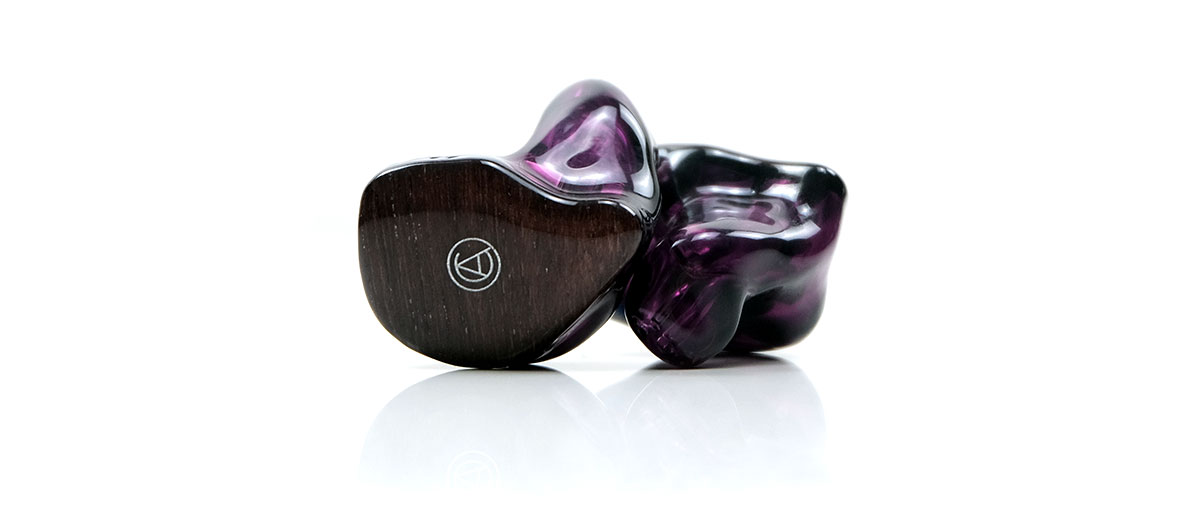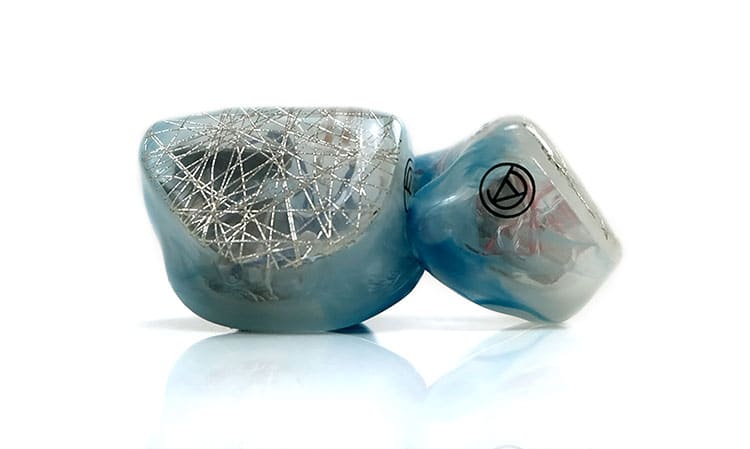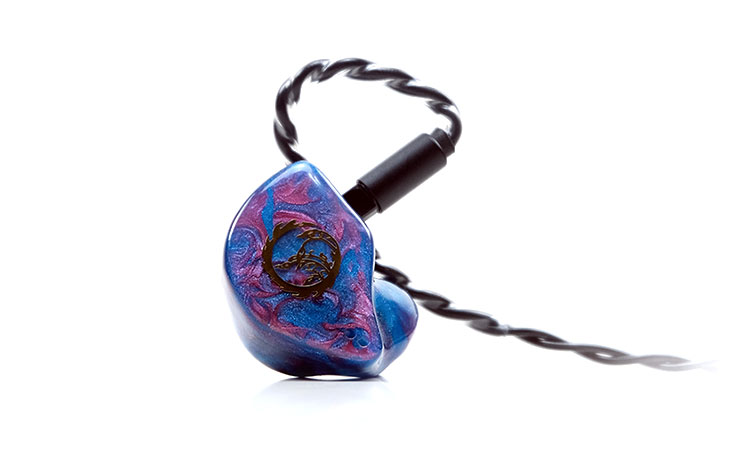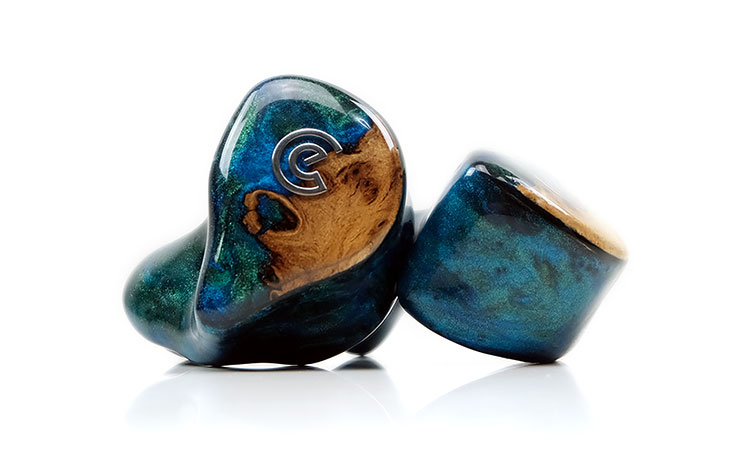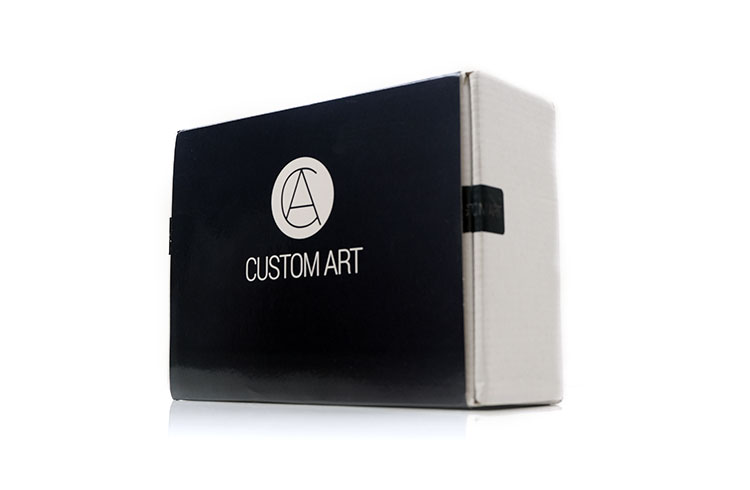Select Comparisons
All select comparisons were completed using a mix of the HiBy RS6 and the Chord Electronics Mojo 2, (paired with a Samsung Z Flip 3), for both source and amplification.
Custom Art FIBAE 7 Unlimited
€1,500
The FIBAE 7 Unlimited is Custom Art’s current flagship custom IEM and replaced the previous FIBAE 7 we reviewed back in 2020. To read our complete opinion on the FIBAE 7 Unlimited from last year click here.
Technical
Since both have FIBAE in the title it’s a safe assumption that the 7 and FIBAE 5 use CA’s proprietary flat impedance technology inside. Where they differ more markedly is in the driver choices and configuration.
The FIBAE 7 Unlimited is an all-BA 7 driver configuration with a dual sub-low woofer, one low-mid, two mid-highs, one proprietary high, and one proprietary tweeter for the super highs.
Whereas the FIBAE 5 uses a tribrid 5-driver design with a 10mm dynamic driver for the lows, dual BA for the mids, and a dual planar tweeter for the highs and super highs.
Both monitors use CA’s new dedicated 3D-printed special waveguide and up-to-date crossover technology though due to the dynamic driver inside the FIBAE 5 you do have that additional venting port as well as the ability to control the bass to a degree with the supplied filter.
The FIBAE 7 Unlimited is more sensitive also when tested against the FIBAE 5 using a low gain SE 3.5mm output from the HiBy RS6. That should be no surprise given the 7 Unlimited is rated at 122dB SPL compared to the FIBAE 5’s less sensitive SPL of 109dB with the same 1kHz @0.1V benchmark.
Design
Both units are custom designs so the final aesthetic is entirely up to your own level of creativity. You can swap them both around so it’s not a fixed look for either monitor.
You could argue that the busier FIBAE 7 Unlimited design is the more intriguing of the two samples with its stunning bespoke ice and wired-themed concept but this will cost you an additional €200. Whereas the FIBAE 5 choice is just €30 for the more serene purple translucent shell and amaranth mix chosen for the FIBAE 5.
A precise and accurate mold will be the other common denominator and since these two units came from different STL files, the FIBAE 5 was shaped just a tiny bit differently on the inside contouring.
Aside from that, the shells were an almost exact duplicate for overall dimension, nozzle depth, and connector sockets, (2-pin). The one obvious difference is the venting port on the FIBAE 5 which means its level of passive isolation is a shade lower than the FIBAE 7 Unlimited’s unvented design.
However, the gap in isolation performances is closed markedly when you insert the filter plug into the FIBAE 5 shell, though at the cost of some bass presence, (around 2.5 dB).
One final note on the cables. The FIBAE 7 Unlimited uses a branded Null Audio Arete which is a 4-wire 24AWG UP-OCC copper build as opposed to the 8-wire SPC version that comes with the FIBAE 5.
I thought the 8-wire SPC competed quite well when comparing side by side. It does not have quite the same smooth tone as the Arete but does have a slightly more expansive sound and enhanced treble sparkle.
Performance
On a technical level, the FIBAE 7 Unlimited has a bit more about it in terms of micro detail and precise imaging. The layering and acoustical arrangement, particularly though the mids is more immediate with its stronger pinna gain and vocal focus also.
However, the sense of scale is a bit larger with the FIBAE 5 which aims more for what you could describe as a macro-level performance. It has a stronger sub-bass presence and some immaculate sounding and airy highs from those planar drivers.
Credit to the FIBAE 7 Unlimited dual woofer ABA setup though, I find it denser and punchier through the mid-bass with a bit more warmth and body to go along with it. I suspect this is where the FIBAE 5 is more scooped out as its punch is generally on the politer side opting instead to focus its energy on delivering an atmospheric style of sub-bass rumble.
Both have some decent 1-3k pinna gain so neither will offer a recessed vocal performance rather the FIBAE 7’s vocal imaging is comparatively further forward with a stronger 2-4k presence that adds a little more solidity.
The FIBAE 5 mids offer a little more contrast in its mids timbre from the planar highs and slightly less body, particularly on the very edge of the lower mids. However, it does sound more open at times compared to the 7 Unlimited when the bass and treble are not being overworked.
Generally, the 7 Unlimited is the more rounded or balanced tuning and the one I would pick if you listen to a very wide range of detail-orientated genres. The FIBAE 5, however, is excellent for modern pop, R’n’B, and EDM where melodic structures are less intimate in the mids or require more depth and headroom.
Unique Melody MEXT
$1399
With a price point not that far from the FIBAE 5 and also with a unique blend of drivers, the MEXT could well be a competitive alternative. Find out what we thought of the MEXT here in our review from last year.
Technical
Like the FIBAE 5, the MEXT is also a tribrid driver design though in this instance there is no planar or EST but rather bone conduction layered on a mix of dynamic and balanced armature drivers.
The precise configuration of the MEXT without the bone conduction is a single 10mm dynamic driver for the lows and four balanced armature drivers with 2 for the mids and 2 for the highs using a 4-way crossover.
The OBC or “Original Bone Conduction” ‘driver’ targets the dynamic driver in this instance with some additional emphasis on the low-frequency response of the MEXT.
The FIBAE 5 is somewhat similar in the driver split with its 10mm for the lows and 2 BA for the mids but it swaps out the dual BA tweeters for the highs and instead uses 2 planar drivers for the highs.
The rating on paper between these two is not that different with the MEXT rated at 16Ω and 108 dB @1kHz SPL and the FIBAE 5 at 10Ω and 109 dB @1kHz @0.1V SPL. Testing both with a Mojo 2 and RS6’s SE output in low gain would seem to place the MEXT as the more sensitive of the two but the gap is not huge.
Design
Again, both are custom designs so the eye candy is not fixed in stone with owner preferences a huge factor in the aesthetics.
This particular MEXT sample uses a W16 or purple maple faceplate which is a lot bolder in color pop than the subtler purples and amaranth of the FIBAE 5. However, you could just as easily ask for something similar from CA and they would probably do it for you to give you that additional color saturation.
One thing to note, it is harder to get the design perfect with UM customs as they do not have any online customization software similar to CA. It’s pretty much an old-school PDF menu and a pick-and-match system.
Despite the design differences, what I can tell you is that the MEXT is a bigger form factor. Probably unsurprising given the use of a bone conduction driver and the space it needs to position itself closer to the shell wall to be effective.
Of the two, the FIBAE 5 also has a slightly shorter nozzle though by no means a relaxed design rather the UM nozzles are just very long. The comfort levels are the exact same, just you can feel that slightly longer nozzle in your ear a bit more compared to the FIBAE 5.
Since both are vented designs the passive isolation is more or less the same. The one benefit of the FIBAE 5 though is the additional filter plug. It not only changes the sound signature but also improves the isolation performance over the MEXT.
Performance
Both of these monitors have elevated bass and in the case of the MEXT more so with an elongated mid-bass elevation and a bit more bloom into the upper bass and lower mids.
Nevertheless, the low-end differences between these two hybrids are not going to be the initial takeaway. Rather, it’s the headroom, upper mids, and treble performance that had my ear for the entire comparison process.
Simply put, the MEXT sounds a lot darker compared to the FIBAE 5, and with a comparatively recessed 2-4k dip that sucks a lot of air out of the MEXT mids giving it a rounded and duller tone.
It lacks a bit of sparkle and energy through the upper mids blunting the performance considerably when compared to the energy and articulation of the FIBAE 5 planar highs.
That can lead to the mids struggling to be heard also when its stronger low-end performance gets going. Whilst the FIBAE 5 mids are not in your face, the better headroom and more spacious acoustical arrangement offer an improved level of clarity for individual notes to be heard more clearly.
The MEXT bass will hit harder and sound more aggressive. It is tuned from the bottom up in that regard with the relaxed upper mids and treble falling fairly far behind in terms of emphasis.
The FIBAE 5 does well for sub-bass presence but has less bloom and a stronger lower-mid cut. The MEXT does a little bit better in terms of lower-mids presence and instrumental note body by comparison whereas the FIBAE 5 does so much better for upper-mids and treble.
Craft Ears Craft 6
€1040
Fellow Polish specialists Craft Ears released the Craft 6 back in 2021 and since our review, it has had a minor nudge up in price to almost the same point as the FIBAE 5. You can read our full take on Craft 6 here.
Technical
The Craft 6 is an all-BA driver design as opposed to a tribrid like the 5-driver FIBAE 5 or even just a ‘regular’ hybrid. It uses a dual sub for the lows, a dual for the low-mids, a single BA for the mid-highs, and one super-tweeter using a 5-way electrical crossover.
Now what is interesting is some of the common design goals these two monitors share. For example, both IEMS are using flat impedance tech with CA’s FIBAE inside the 5, and Craft Ears’ own version called True Load.
Another example is the application of internal 3D printing for acoustical tuning purposes. The FIBAE 5 uses its crossover combined with a dedicated 3D-printed special waveguide to up the sensitivity as well as improve the high-frequency performance of those planar tweeters.
The Craft 6 uses the company’s RASEN tech which is a 3D-printed structure placed on the bass tube of the bass driver. It acts as a ‘damperless’ low pass filter with decay extension.
On paper, Craft 6 is rated at just 7Ω as opposed to 10Ω for the FIBAE 5 so neither really needs huge reserves of voltage to be driven properly.
Curiously, the Craft 6 has no SPL rating so we reverted to a more subjective side-by-side test with the Mojo 2 and RS6 both showing the Craft 6 to be marginally more sensitive to current and gain than the FIBAE 5.
Design
My main critique though of the Crafts Ears process is the lack of an online configurator to allow you to custom design the Craft 6. Instead, it’s more about what you see in their online gallery and any discussion you might have with the team.
Having said that their designs have some elegance about them and there seem to be no additional charges with the above sample called Ocean Blue. This is comprised of two parts; an ocean blue lightly speckled solid color shell finish, and a faceplate comprising a mix of stabilized resin wood and a marine-themed swirl.
There is a difference in the form factor with the Craft 6 the slightly bigger and fatter of the two, particularly in the nozzle. Both fits are very accurate but CA has narrowed and shortened the nozzle a little so it sits inside the ear canal without too much pressure.
The Craft 6 has a fatter almost bulbous nozzle meaning it will present a tighter fit with more internal pressure on the canal opening. And, because of the more bulbous shell the Craft 6 sticks out of your ear a little more than the FIBAE 5.
Since the Craft 6 is an all-BA monitor there is no venting so passive isolation performance is stronger than the vented FIBAE 5. Mind you, the FIBAE 5 closes the gap with the insertion of the supplied filter.
Cables. They seem remarkably similar to each other and makes me wonder if both firms are dipping their toes into the same cable factory well.
Both are 1.2m 8-core SPC wires and though there is a slight difference in the choice of barrel designs the materials and finishing are almost the same save for the cheaper plastic chin cinch on the Craft 6.
Performance
The Craft 6 is the more neutral or reference-like of the two monitors. It doesn’t mess around too much with the timbre sounding very balanced in its harmonic coloration.
It has a mild 20-100Hz bump, a decent punchy mid-bass then runs very linear up to 1-2k with a slight pinna gain increase around the 1-3k marker.
Vocals are clear and smooth sounding though not massively forward and have a neutral to natural overtone with a decent mid-treble lift around 5-7k but nothing too spikey. What it lacks is some 4-5k energy that blunts the harmonics a little with less headroom beyond 8k.
The FIBAE 5’s more unique coloration and imaging arrangement provide a more interesting dimension to music for my tastes and though certainly not a neutral or reference tuning you could argue it’s the more engaging of the two.
It delivers more weight on the low-end and much more treble presence and upper treble extension giving it a roomier staging quality in general. Vocals are a little further forward also, and you can pick that imaging change quite easily on solo vocalists that hover around the FIBAE 5’s 1-3k range.
Granted, the treble energy is going to color the FIBAE 5 mids a bit more sounding leaner at times on percussion hits and some synth notes but it never translates into irritation or fatigue.
Ultimately, this is a preference thing so if you want it straight up and true then the Craft 6 is more likely to appeal but if you want a stronger level of PRaT, more headroom and that excellent planar sparkle and energy then the FIBAE 5 is the more enjoyable listen.
Our Verdict
The Custom Art FIBAE 5 is a tribrid driver monitor that hits a bit differently. We are talking about excellent physical planar tweeter highs, a surprisingly spacious midrange, and a low-end that digs deep but is not overbearing or full of bloom.
Is it the heaviest-sounding dynamic driver woofer out there? No, but give it some power or a decent amp and it can sound snappy and fairly dynamic in its delivery. I guess that is what CA wanted out of this tuning, something that brought the power game but without killing the rest of the frequency response in the process.
Don’t forget, this is a custom version so you do get all the benefits of an accurate fit and an attractive design also.
Who should get the FIBAE 5? It’s a fun listening experience with good technical capability. It’s not a referencing tool rather it’s for enjoyment with rhythmic-orientated genres that need a bit of space to shine.
Custom Art FIBAE 5 Technical Specifications
- Single 10mm Dynamic Driver Sub-Low, dual BA Mid, single Planar High, single Planar Super High
- 109dB @1kHz @0.1V
- 3D-printed waveguide
- 10 Ohm @1kHz (+-2 Ohm 10Hz-20kHz)
- 10Hz-21000Hz (+-5dB into IEC 60318-4 coupler)
- Custom or universal fit




